Ten Tips for Living and Thriving in Thailand
By Brittany Rohm
Published 10/17/2018 by Transitions Abroad
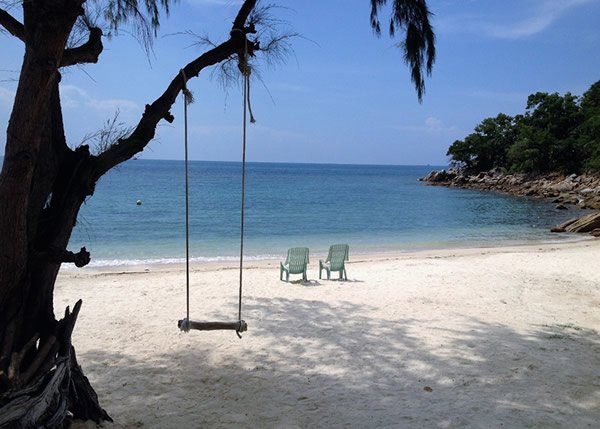 |
| Paradise awaits those who plan to visit — or live in — Thailand. |
Towering palm trees swaying in the sea-salt breeze. Verdant jungles housing elephants, gibbons, and deer. Incense wafting out of mountaintop temples. Sand the color of lightly toasted sugar squishing underfoot. Outdoor markets bustling with friendly vendors, skilled craftsmen, and dulcet musicians. Monks draped in sunburst-colored robes zipping by on the backs of motorbikes. Thailand, also known as the "Land of Smiles," has something for everyone.
After traveling around Thailand for more than six months — enjoying the stunning nature, the mouth-watering food, the exciting adventures, and the generous people — I decided to volunteer as an English teacher in the small town of Betong.
Located in the far southwest corner, Betong is home to the world’s largest mailbox, an ethereal cloud forest, and approximately 25,000 residents, almost all of which speak nothing but Thai. So few people are conversant in English that — in addition to working with numerous school children — I held Saturday sessions for adults and even gave the mayor private lessons.
At first, I added my own footprints to the well-trodden tourist track. Then I explored more seldom-visited places. And finally, I lived in a wonderfully quirky town that saw zero Westerners (besides myself) the whole time I was there. For those reasons, I feel qualified to provide overseas adventurers with ten tips for thriving in Thailand.
Whether you choose to live, volunteer or work in the vibrant Land of Smiles, I believe your experience will be all the better if you:
1) Find your Inner Monk
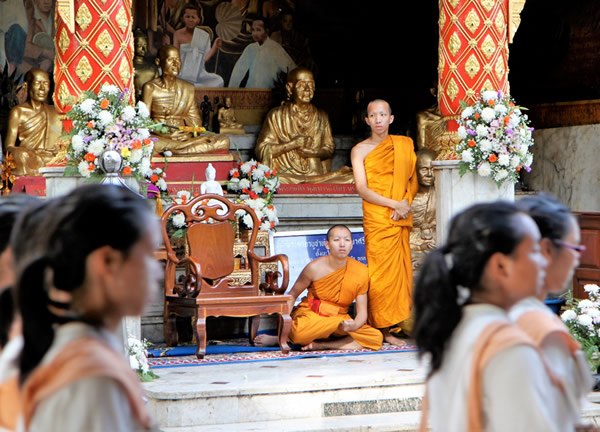 |
| Two monks watch a processional during the annual Chiang Mai University Welcoming Celebration at Doi Suthep. |
By nature, Thai people are calm and mild-mannered. Nearly 95% of the nation’s population practices Buddhism, which teaches that by following the Noble Eightfold Path, one can end the perpetual cycle of suffering, death, and rebirth achieve enlightenment instead. One of the path’s divisions is “moral virtues,” which includes directions such as “no taking what is not given” and “no rude speech.” These and similar guiding principles can be seen in the way the locals act both towards each other and towards farangs (foreigners).
While you don’t need to attend one of the nation’s silent meditation retreats that are popular with locals and farangs alike, or even visit any of the countless Buddhist monasteries that dot the country, it’s a good idea to be calm, respectful, and courteous in your actions and your speech. The Thai people strongly believe in the idea of saving face and therefore rarely show anger or even frustration, and it would behoove of any short- or long-term visitor to do the same.
2) Learn the Lingo
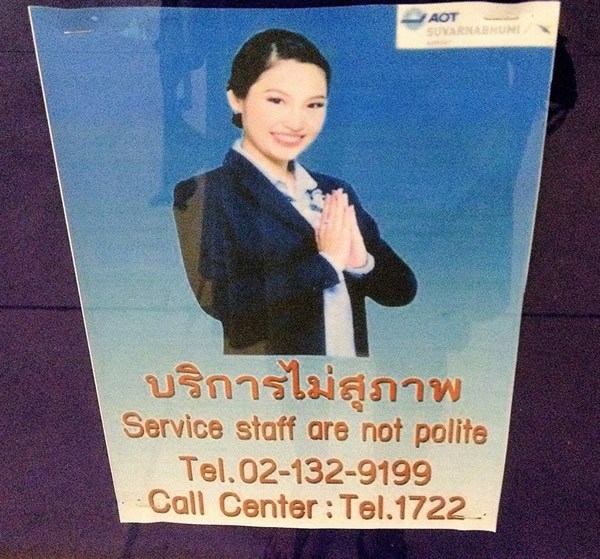 |
| Sometimes, things get lost in translation, but a smile and bow are always understood in Thailand. |
Thai is both a tonal language and one that uses characters not found in any other country’s mother tongue, making it difficult to learn. (Despite living in Thailand and being surrounded by people who spoke little to no English, I learned only a few Thai words and phrases; however, this was in part because the locals wanted to learn English, not teach Thai). That said, learning “hello” and “thank you” in Thai can make anyone’s time in-country more enjoyable.
Coupled with saying “sawasdi ka” (“hello” if you’re a female) and “sawasdi krup” (“hello” if you’re a male), or “kop Kuhn ka” (“thank you” if you’re a female) and “kop Kuhn krup” (“thank you” if you’re a male), it’s good to learn the accompanying gesture that is used during greetings. To perform the Wai, place your hands together as if to pray, hold them at chest level, and bow slightly with your head and upper body. Keep in mind that the Wai is performed based on age and status, so a younger person, for example, would offer the greeting to an elder, but not the other way around.
3) Dress to Impress (the Locals, not the other Farangs)
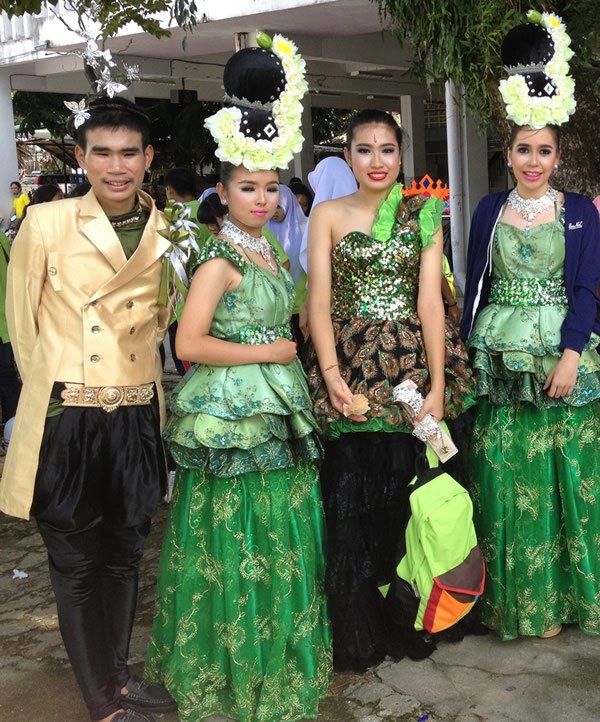 |
| Students at Betong Weraratphasan High School don cultural garb for a festival. |
Modesty is an important aspect of Thai culture, and it should not be abused simply because so many farangs flout it. While it’s common to see foreigners wearing tank tops, midriff-baring shirts, short shorts or baggy shorts, pay attention to how the locals dress. Usually, men wear fitted jeans or pants, and lightweight long-sleeve shirts, often with collars. Women tend to wear loose-fitting shirts, and pants or long skirts.
There are additional benefits to covering up:
- The sun can be intense, even on cloudy days, so long sleeves and pants can help protect your skin from powerful UV rays.
- Such clothing can keep mosquitoes and flies from biting you, as they are inclined to do, especially at dusk.
- If you get into a motorbike accident, you’ll be less prone to “road rash” (scrapes from getting into motorbike accidents) if you’re not baring your arms or legs.
4) Drive Responsibly
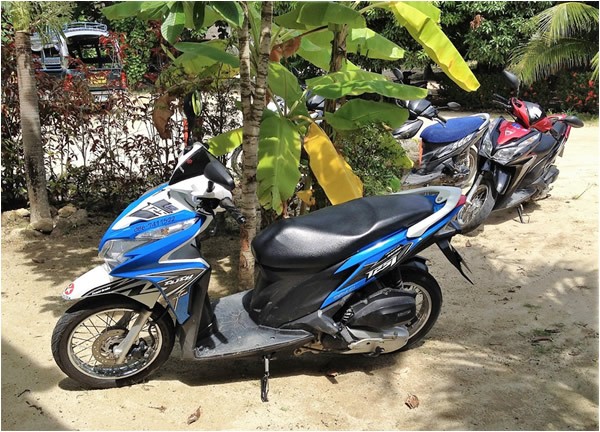 |
| Motorbikes make getting around Thailand easy and fun, as long as you drive safely. |
Chances are good that if you’re living in Thailand, or even spending a significant amount of time there, you’ll be renting or buying a motorbike to get around. Motorbikes are a common mode of transportation for locals and farangs alike because they’re relatively inexpensive, they’re convenient, they allow you to go quickly from place to place, and having one means you don’t need to rely on the ubiquitous tuk tuks or songthaews — both taxis, of sorts.
That said, motorbikes can also be dangerous if you don’t know how to drive them properly, or if you drive them at night and/or under the influence. The same rules of the road should apply in Thailand as they do everywhere else, yet there seem to be an awful lot of “traveler’s tattoos” (see “road rash” issue above). You can avoid becoming another pavement-stamped driver by practicing in an alley or on a little-used road before heading out to the main streets, and by avoiding driving after you’ve been drinking. Tuk tuks and songthaews are both cheap alternatives to copious amounts of bandages at best, and medical bills at worst.
5) Shop Locally
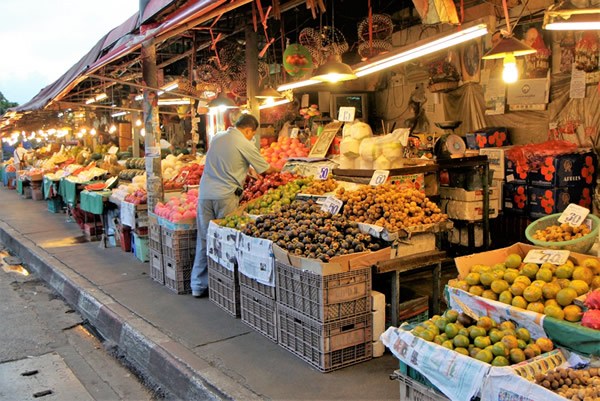 |
| A man arranges his produce at a night market in Chiang Mai. |
With an abundance of open-air markets set up throughout the country, where vendors hawk everything from handmade clothing to durian fruit (aka “stinky fruit”) to fried insects, there’s no reason not to shop where the locals do. (Okay, so maybe stinky fruit and fried bugs aren’t your cup of tea, but you also won’t know that until you try them). Whether you go during the day for some fruit, or at night for fresh food and live music, markets can make for fun outings. What’s more, the goods cost less than they do in the brick and mortar stores — if you can even find similar products — and you’re helping to support the local vendors.
Chiang Mai boasts one of the nation’s best night bazaars, where you’re sure to find artwork for your new Thailand digs; comfortable, lightweight clothing appropriate for any wat; produce for the pantry, and dinner and a fruit shake to enjoy while you’re purchasing everything else. You can also find electronics, knock-off designer items and just about anything you can imagine. Remember to barter like the locals!
6) Eat Street Food
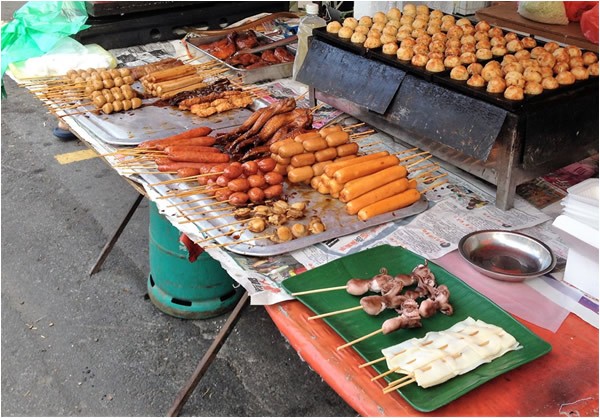 |
| Grilled meat on a stick is common fare among street food vendors in Thailand. |
It’s seemingly impossible to walk or motorbike more than a few kilometers in any Thai town without coming across at least one street cart or food stall. Whether you’re craving something sweet, salty, or savory — or maybe a little of all three — you’re bound to be in luck. Vendors skewer and grill everything from chicken to pork to squid, and you should have no trouble finding pad Thai, fried rice, or drunken noodles if you prefer a meatless diet. For dessert, you can indulge in a large crepe-like pancake filled with your choice of fruit and toppings (might I suggest bananas and Nutella?).
Sampling street eats can be fun, and in addition to supporting “small business” owners such that the money goes back to the local economy, you can also make certain that you’re ingesting fully cooked meat or the freshest fruit shakes your 40 baht (US$1.25) can buy. After all, you get to watch your drink, snack, or dinner prepared right before your eyes. If you’re on the lookout for a quick bite and you don’t see any smoke spiraling into the air, just follow your nose; you’re sure to come across something delicious, inexpensive, and truly authentic.
7) Show Some Respect
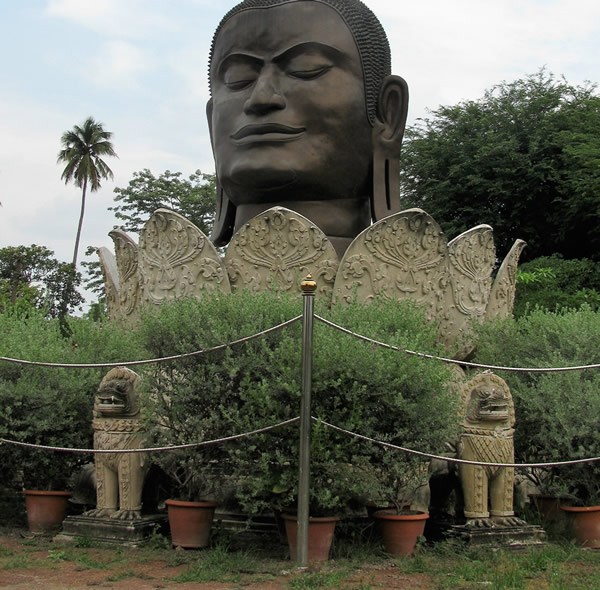 |
| Taking photos of Buddha is fine in Thailand, as long as you don’t turn your back on the statue. |
Thailand, like any country, has its own unique culture and traditions. Many festivals, ceremonies, and holidays center around Buddhism, and they offer visitors and residents alike wonderful opportunities to better experience the nation’s predominant religion. As expressed in #3, always dress appropriately when attending such events, as you want to focus on the locals, not have the locals turn all their attention on you.
Also, while Thai people are typically easygoing and nonconfrontational, they do consider certain actions to be rude. Displaying a lot of affection for your significant other, for example, is deemed impolite, as is pointing with your finger, placing your feet higher than someone’s head, and posing for a photo with your back turned to Buddha. Cleanliness is a top priority as well, and it’s accepted — and even expected, at times — to remove your shoes before entering the establishment.
8) Get Off the Beaten Path
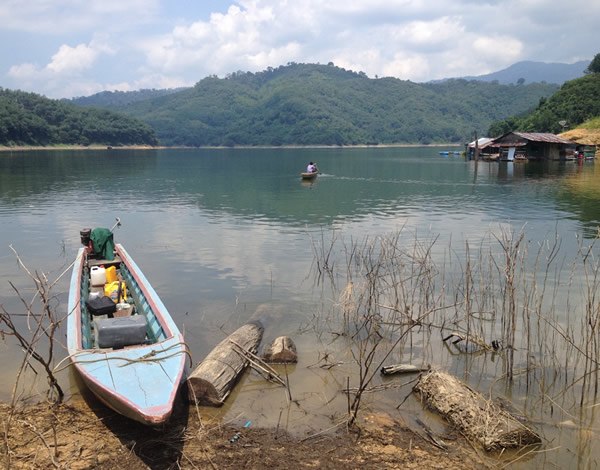 |
| Touring Bang Lang Dam in Hala-Bala Wildlife Sanctuary, near the Thailand-Malaysia border. |
While destinations like Koh Samui, Chiang Mai, and Bangkok are popular for a number of reasons, Thailand boasts more than just these well-known, well-trodden, locales. There are many volunteer and paid-work opportunities throughout the country, but if you find yourself living in one of the more regularly frequented cities, be sure to get out and explore a few far-flung places when time permits.
From motorboating around Bang Lang Dam in Hala-Bala Wildlife Sanctuary to trekking through the 160-million-year-old jungles of Khao Sok to soaking up the sun on quiet Koh Bulon Lae, Thailand offers a wide variety of interesting and stunning options for those who are looking to stray from the beaten path. Taking buses, tuk tuks, songthaews, and ferries are easy, affordable ways to get around the country, and there’s sure to be at least one hidden gem that’s ideal for your needs.
9) Stay Itch- (and Disease-) Free
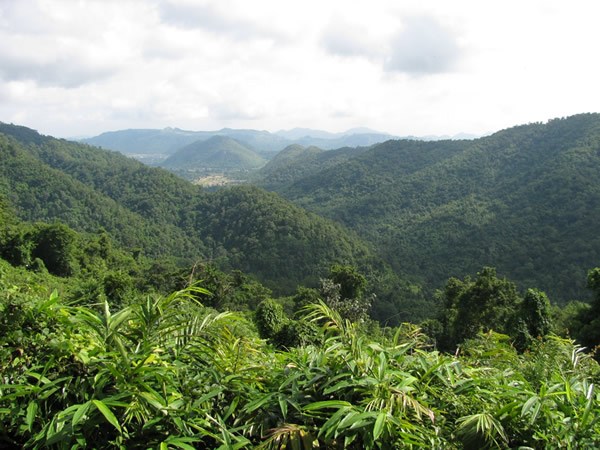 |
| Jungles abound in Thailand. While beautiful, they are havens for mosquitoes and other insects. |
Mosquitoes are arguably an essential part of nature, but that doesn’t mean you have to like them — or let them feast on you. Thailand’s rainy season runs from June to October, and that’s when the mosquitoes are the worst. However, they are bothersome year-round. In addition to causing the typical itchiness you have no doubt experienced, mosquitoes in Thailand can also transmit dengue fever, a disease that can cause severe joint and muscle pain, nausea, exhaustion, and more.
To ward off the pesky insects, always apply plenty of mosquito repellent to exposed skin, especially during dusk and dawn, when the bugs are out in force. If you do get bit, using Tiger Balm (which can usually be found in Tesco Lotus and 7-Eleven) can help alleviate the itch. The ointment will not protect against dengue fever, though, so it’s best to cover up when you go out near sunup and sundown.
10) Smile
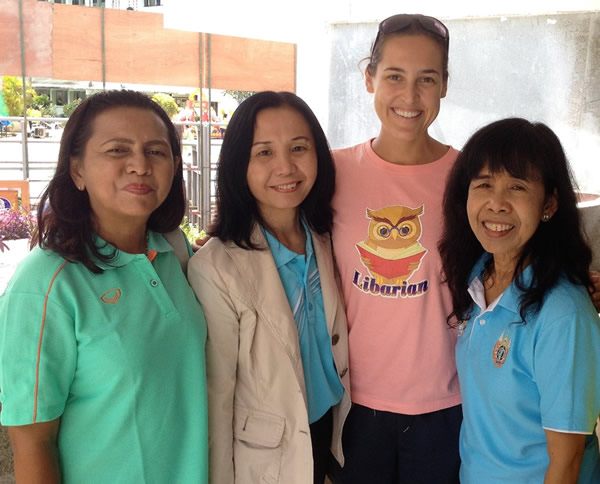 |
| The author poses with some of her fellow teachers at Betong Weraratphasan High School in Betong. |
It is thought that Thailand was first nicknamed the Land of Smiles as a promotional tool to attract visitors with the promise of being welcomed by friendly, hospitable locals. Whether the promotional aspect is true or not, it is undeniable that the Thais are a courteous, helpful people, and that they really do smile a lot.
Known as yim in Thai, a smile is so common in the country that it could actually mean one of 13 things. Instead of visually expressing anger, frustration, or anxiety, for example, Thais often smile. Sometimes they smile to be polite, other times to convey an apology, and other times to display genuine contentment. Any way you look at it, smiling is an important aspect of their culture, and when in doubt — even if you’re feeling annoyed, or dissatisfied in some way — consider turning the corners of your mouth up like the locals so often do. It could make you actually feel happier, but if not, your grin is likely to make someone else happy.
More on Volunteering, Working, and Living in Thailand
A visa is required for most (short- and long-term) visitors to Thailand, whether for purposes of tourism, business, study, or other reasons. First check Royal Thai Consulates in your home country for more detailed information on what can sometimes be an involved process.
Volunteer opportunities abound in Thailand, but some organizations that offer such opportunities are more trusted and well-known than others.
Volunteer Work Thailand is a site that lists a wide range of volunteer opportunities throughout the country, some of which charge a nominal placement fee but many of which charge nothing and instead offer room and/or board.
HelpX (Help Exchange) charges a €20 membership fee for 2 years. It offers and an online directory of host farmstays, homestays, ranches, lodges. Each of these offerings provides room and/or board in exchange for volunteer help.
Workaway charges a $49 membership fee and is an online community that connects volunteers with local hosts where work is exchanged for room and/or board.
WWOOF Thailand (Willing Workers On Organic Farms) charges a nominal membership fee and links volunteers with local hosts who may be seeking everyone from farmhands to eco-friendly home builders in exchange for providing room and/or board.
|
|
Born and raised in Alaska, Brittany Rohm grew up with an adventurous spirit and a desire to travel the world. Her wandering feet have taken her to more than forty countries across six continents, and she has camped in electrical storms, hiked active volcanoes, and been stung by a jellyfish. She works as a freelance editor and explores new places as often as possible.
|
|
